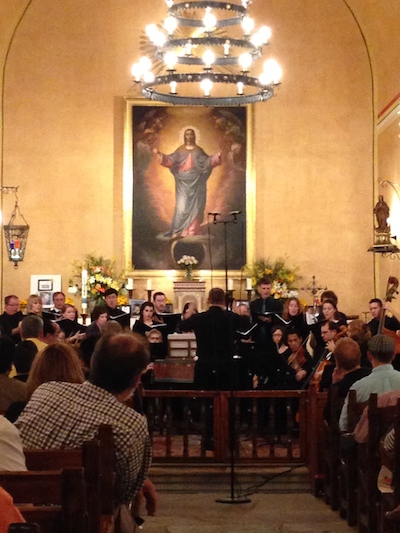

The weekend: Modigliani Quartet; Austin Baroque Orchestra
Music rarefied and rare
November 19, 2013The weekend brought visiting ensembles from near (the Austin Baroque Orchestra) and far (the Modigliani Quartet of Paris).
The air was cool, literally and figuratively, in Temple Beth-El on Sunday when the Modigliani Quartet gave an elegantly executed concert of Haydn, Beethoven and Dohnanyi for the San Antonio Chamber Music Society.
The Modigliani was formed in 2003 by four students at the Paris Conservatoire — violinists Philippe Bernhard and Loïc Rio, violist Laurent Marfaing and cellist Francois Kieffer.
It is perhaps apt that the quartet borrowed its name from Amadeo Modigliani, a Jewish Italian artist who moved to Paris in his early 20s and there developed his signature style, a brand of figurative Modernism that was restrained in composition and palette but idiosyncratic in form.
On the whole, the quartet’s style was patrician and a trifle distant. Chordings were carefully balanced, the ensemble sound was creamy, and dynamics skewed to the quiet side. Except in the opening allegro of Haydn’s first “Prussian” Quartet, Op. 50, No. 1, where Mr. Bernhard was having intonation difficulties, the troupe was scrupulously in tune.
The Haydn suffered from dispassion, or maybe just excess caution. The quartet played as if walking on tiptoe, and too much of the music seemed enervated.
Beethoven’s valedictory string quartet, the compact Op. 135 in F, fared better, mainly on the strength of an exquisitely rarefied, unutterably beautiful account of the slow movement. The playing in the quicker movements was straightforward and somewhat analytical, bringing the details of construction to the fore.
Both the Haydn and Beethoven quartets, however, were marred by rhythmic idiosyncrasies, mainly from Mr. Bernhard’s violin. In the Beethoven slow movement, for eample, he broke the six-note phrase that begins the theme into two distinct three-note groups. In the Haydn, he would often hold a note too long and then pounce on the following notes, distorting the shape of a phrase. The consistency of these rhythmic oddities in analogous passages indicates deliberate interpretive choices.
The Modigliani made a good case for Erno Dohnanyi’s String Quartet No. 3 in A Minor, composed in 1926 when the Hungarian composer and conductor was living in the United States. Dohnanyi’s music in general, and this finely crafted quartet in particular, receive too little exposure in concert programs. The piece is eventful and well argued, bracing in its complex tonal harmonies, meaty but not intimidating.
On Saturday night, the period-instruments Austin Baroque Ensemble and its Settecento chorus brought a generous (to a fault) program of music from New Spain to Mission Concepcion. From the concert’s exhausting three-hour span (plus half-hour pre-concert talk), you might surmise correctly that the troupe’s artistic director and conductor, Billy Traylor, is by training a musicologist.
Most of the composers were 17th- and 18th-century transplants to Latin America from Spain, Italy and Portugal. The brilliant Manuel de Zumaya, whose intricately constructed “Angelicas milicias” closed the concert, was the sole mestizo on the program.


 American church
archives. Some of it is of very high quality, some not.
American church
archives. Some of it is of very high quality, some not. The one purely instrumental work on the program, a Sinfonia in F in Italian baroque style by the Spaniard Jose Herrando, was pretty thin soup except for the slow movement’s plangent dissonances. From Santiago Billoni, an Italian who worked for the church in Durango, Mexico, came “Por que, Pedro,” a dialog between Jesus (set for soprano, following the baroque custom of assigning the noblest characters the highest voices) and Peter (bass); the music is well-crafted but not notably inventive.
More interesting was a setting of Psalm 112, “Beatus vir,” by Domenico Zippoli, an Italian who worked in Paraguay. With its pleasurable, sensuous counterpoint, its dramatic alertness and its pictorial strokes, this music stands up well among its Italian baroque contemporaries. Soprano Jenny Houghton sang the demanding solo part with excellent agility and aptly boyish timbre.
Certainly among the finest of the European composers in New Spain was Juan Gutierrez de Padilla, who was appointed chapel master at Puebla in 1629. He was represented on this program by two a capella works, “Tristis est anima mea” and “Pater paccavi,” both of which were superb examples of Spanish Renaissance style. The latter , relating the father’s joyful reception for his returning prodigal son, is particularly complex in its interplay of voices. Both were splendidly sung by the chorus, evidently well trained by Brad Reid.
The concert attained its peak in aural spectacle with “Dan, dan, dan, dan, fuego en la casa de Adán” by the eminent Portuguese, Gaspar Fernandes, Padilla’s predecessor at Puebla. With its large orchestra including brass and drums, this celebratory piece oozed color from every pore.
Highly skilled playing abounded in the orchestra, which numbered more than two dozen and included the estimable Scott Horton on theorbo. Mr. Traylor did not always hold his large forces together as tightly as one might wish — a tough challenge in the highly resonant space of Mission Concepcion — but he brought a nice swing to much of the music. His striving for authenticity extended to pitch — about a half-step lower for the 18th-century pieces — and to Latin, Spanish and Quechua diction, coached by Howard Burkett, a tenor in the chorus.
Mike Greenberg
Austin Baroque Orchestra and Settecento chorus in Mission Concepcion